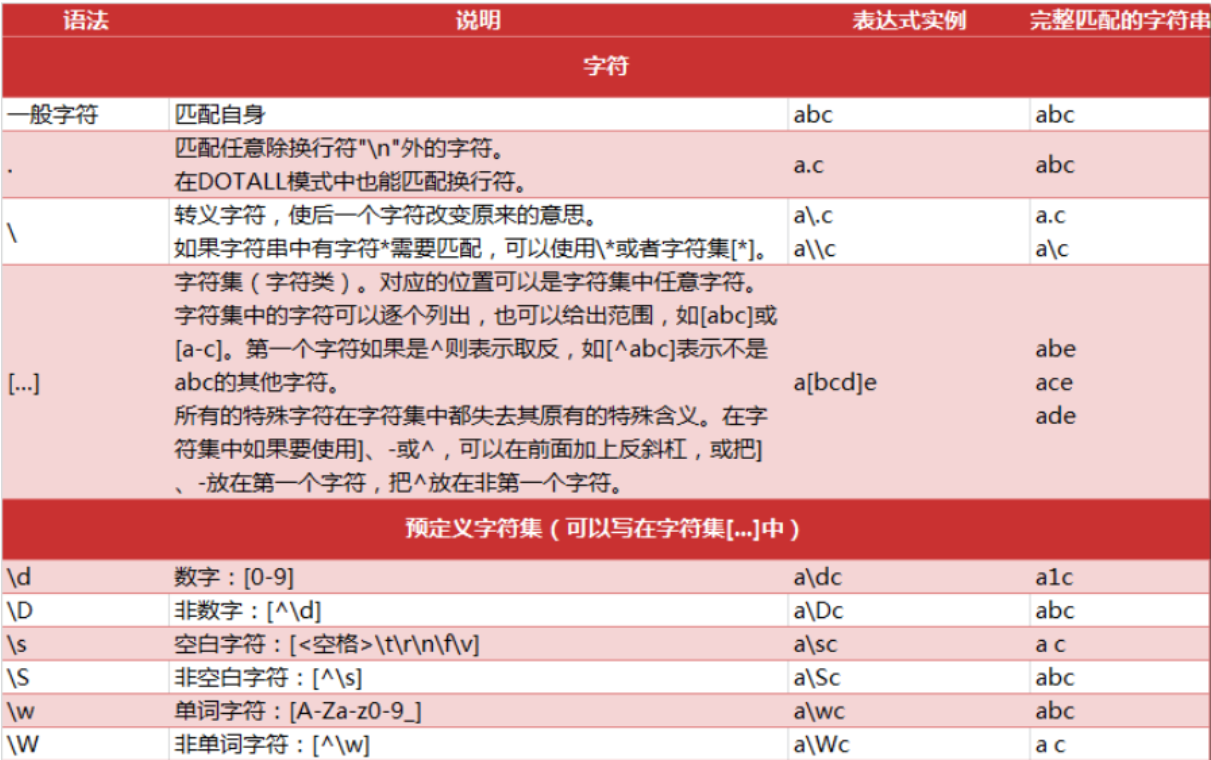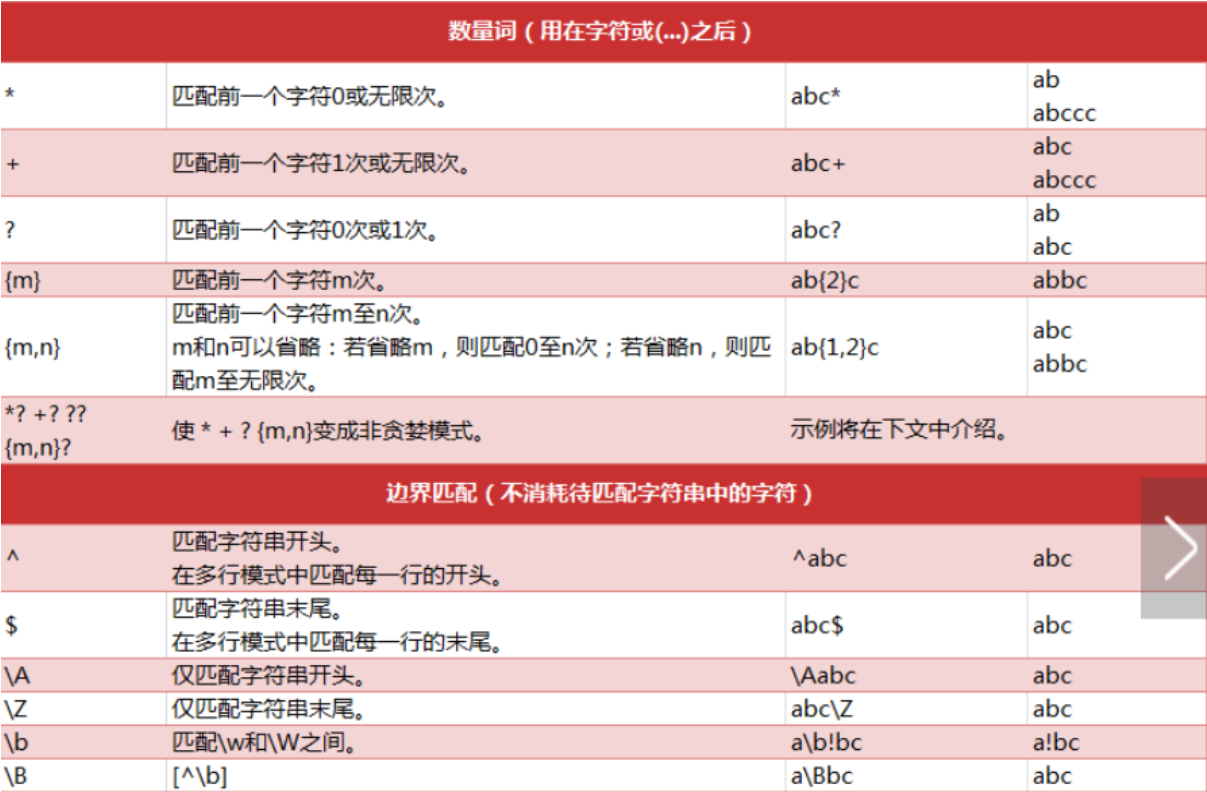正则表达式语法


Python正则表达式
-
指定好匹配的模式-pattern
-
选择相应的方法-match,search等
-
得到匹配结果-group
-
re.match #从开始位置开始匹配,如果开头没有则无
-
re.search #搜索整个字符串
-
re.findall #搜索整个字符串,返回一个list
input = '自然语言处理很重要 。 12abc789'
import re
pattern = re.compile(r'.')
re.findall(pattern,input)
['自',
'然',
'语',
'言',
'处',
'理',
'很',
'重',
'要',
' ',
'。',
' ',
'1',
'2',
'a',
'b',
'c',
'7',
'8',
'9']
字符集合
- [abc] 指定包含字符
- [a-zA-Z] 来指定所以英文字母的大小写
- [^a-zA-Z] 指定不匹配所有英文字母
pattern = re.compile(r'[abc]')
re.findall(pattern,input)
['a', 'b', 'c']
pattern = re.compile(r'[a-zA-Z]')
re.findall(pattern,input)
['a', 'b', 'c']
pattern = re.compile(r'[^a-zA-Z]')
re.findall(pattern,input)
['自',
'然',
'语',
'言',
'处',
'理',
'很',
'重',
'要',
' ',
'。',
' ',
'1',
'2',
'7',
'8',
'9']
或方法
将两个规则并列起来,以‘ | ’连接,表示只要满足其中之一就可以匹配。
- [a-zA-Z]|[0-9] 表示满足数字或字母就可以匹配,这个规则等价于 [a-zA-Z0-9]
pattern = re.compile(r'[a-zA-Z]|[0-9]')
re.findall(pattern,input)
['1', '2', 'a', 'b', 'c', '7', '8', '9']
匹配数字 ‘d’ 等价于 [0-9]
pattern = re.compile(r'd')
re.findall(pattern,input)
['1', '2', '7', '8', '9']
‘D’ 匹配非数字
pattern = re.compile(r'D')
re.findall(pattern,input)
['自', '然', '语', '言', '处', '理', '很', '重', '要', ' ', '。', ' ', 'a', 'b', 'c']
‘w’ 匹配字母和数字
pattern = re.compile(r'w')
re.findall(pattern,input)
['自',
'然',
'语',
'言',
'处',
'理',
'很',
'重',
'要',
'1',
'2',
'a',
'b',
'c',
'7',
'8',
'9']
W’ 匹配非字母和数字
pattern = re.compile(r'W')
re.findall(pattern,input)
[' ', '。', ' ']
‘s’ 匹配间隔符
pattern = re.compile(r's')
re.findall(pattern,input)
[' ', ' ']
重复
正则式可以匹配不定长的字符串
‘*’ 0 或多次匹配
pattern = re.compile(r'd*')
re.findall(pattern,input)
['', '', '', '', '', '', '', '', '', '', '', '', '12', '', '', '', '789', '']
‘+’ 1 次或多次匹配
pattern = re.compile(r'd+')
re.findall(pattern,input)
['12', '789']
‘?’ 0 或 1 次匹配
pattern = re.compile(r'd?')
re.findall(pattern,input)
['',
'',
'',
'',
'',
'',
'',
'',
'',
'',
'',
'',
'1',
'2',
'',
'',
'',
'7',
'8',
'9',
'']
精确匹配和最小匹配
‘{m}’ 精确匹配 m 次
pattern = re.compile(r'd{3}')
re.findall(pattern,input)
['789']
{m,n}’ 匹配最少 m 次,最多 n 次。 (n>m)
pattern = re.compile(r'd{1,3}')
re.findall(pattern,input)
['12', '789']
match 与 search
它们的返回不是一个简单的字符串列表,而是一个 MatchObject,可以得到更多的信息。
如果匹配不成功,它们则返回一个 NoneType 。所以在对匹配完的结果进行操作之前,必需先判断一下是否匹配成功了。
match 从字符串的开头开始匹配,如果开头位置没有匹配成功,就算失败了;而 search 会跳过开头,继续向后寻找是否有匹配的字符串。
input2 = '123自然语言处理'
pattern = re.compile(r'd')
match = re.search(pattern,input2)
match.group()
'1'
字符串的替换和修改
在目标字符串中规格规则查找匹配的字符串,再把它们替换成指定的字符串。你可以指定一个最多替换次数,否则将替换所有的匹配到的字符串。
sub ( rule , replace , target [,count] )
subn(rule , replace , target [,count] )
第一个参数是正则规则,第二个参数是指定的用来替换的字符串,第三个参数是目标字符串,第四个参数是最多替换次数。
sub 返回一个被替换的字符串
subn 返回一个元组,第一个元素是被替换的字符串,第二个元素是一个数字,表明产生了多少次替换。
pattern = re.compile(r'd')
re.sub(pattern,'数字',input2)
'数字数字数字自然语言处理'
pattern = re.compile(r'd')
re.subn(pattern,'',input2)
('自然语言处理', 3)
split 切片函数。使用指定的正则规则在目标字符串中查找匹配的字符串,用它们作为分界,把字符串切片。
split( rule , target [,maxsplit] )
第一个参数是正则规则,第二个参数是目标字符串,第三个参数是最多切片次数,返回一个被切完的子字符串的列表
input3 = '自然语言处理123机器学习456深度学习'
pattern = re.compile(r'd+')
re.split(pattern,input3)
['自然语言处理', '机器学习', '深度学习']
‘(?P…)’ 命名组
<…>’ 里面是你给这个组起的名字,
pattern = re.compile(r'(?P<dota>d+)(?P<lol>D+)')
m = re.search(pattern,input3)
m.group('lol')
'机器学习'
例子
# 筛选号码
input = 'number 338-343-220'
pattern = re.compile(r'(ddd-ddd-ddd)')
m = re.search(pattern,input)
print(m.groups())
('338-343-220',)